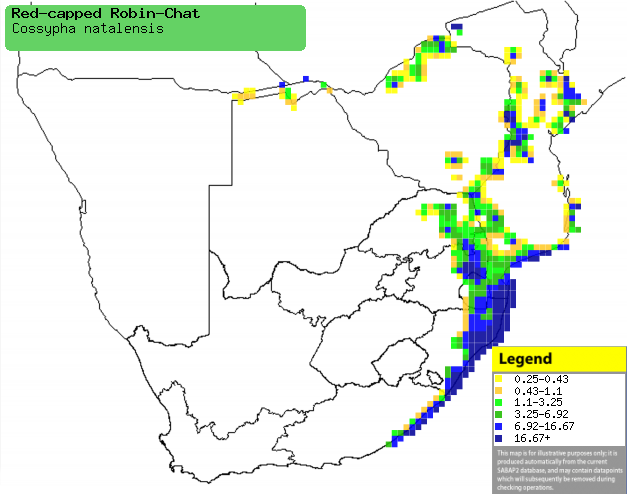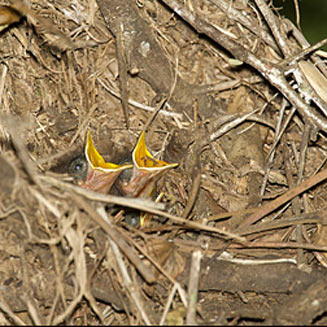|
Cossypha natalensis (Red-capped
robin-chat, Natal robin)
Nataljanfrederik [Afrikaans]; Nyarhututu
[Tsonga]; Roodkap-lawaaimaker [Dutch]; Cossyphe à calotte rousse
[French]; Natalrötel [German]; Cossifa do Natal [Portuguese]
Life
> Eukaryotes >
Opisthokonta
> Metazoa (animals) >
Bilateria >
Deuterostomia > Chordata >
Craniata > Vertebrata (vertebrates) > Gnathostomata (jawed
vertebrates) > Teleostomi (teleost fish) > Osteichthyes (bony fish) > Class:
Sarcopterygii (lobe-finned
fish) > Stegocephalia (terrestrial
vertebrates) > Tetrapoda
(four-legged vertebrates) > Reptiliomorpha > Amniota >
Reptilia (reptiles) >
Romeriida > Diapsida > Archosauromorpha > Archosauria >
Dinosauria
(dinosaurs) > Saurischia > Theropoda (bipedal predatory dinosaurs) >
Coelurosauria > Maniraptora >Aves
(birds) > Order: Passeriformes
> Family: Muscicapidae > Genus: Cossypha
Distribution and habitat
Although it has scattered populations above the equator,
the bulk of its population occurs from southern DRC and Tanzania south through
Angola, Zambia and Malawi to southern Africa. Here it is fairly common in the
Caprivi Strip (Namibia), northern and south-eastern Zimbabwe, Mozambique and
eastern South Africa, from Limpopo Province through Mpumalanga and KwaZulu-Natal
to East London, in the Eastern Cape. It generally prefers evergreen forest along
watercourses, riparian thickets in bushveld, dune forest, well-wooded suburban
gardens and banana plantations. It may also occupy miombo (Brachystegia)
woodland and hillside drainage lines in river valley bushveld.
|
 |
|
Distribution of Red-capped robin-chat in southern Africa,
based on statistical smoothing of the records from first SA Bird Atlas
Project (©
Animal Demography unit, University of
Cape Town; smoothing by Birgit Erni and Francesca Little). Colours range
from dark blue (most common) through to yellow (least common).
See here for the latest distribution
from the SABAP2. |
Brood parasites
It has been recorded as host of the
Red-chested cuckoo.
Movements and migrations
Complex and not well known, as it is though to
be resident in some areas (such as the KwaZulu-Natal coast) and
migratory in others.
Food
It eats mainly eats insects, supplemented with fruit taken
from the tree canopy. It does most of its foraging on the ground, whisking
through leaf litter in search of prey, occasionally hawking insects on tree
trunks or in the air. The following food items have been recorded
in its diet:
- Invertebrates
- Fruit
- asparagus
- Asparagus densiflorus
- Asparagus falcatus
- Asparagus plumosus
- Scadoxus
- Scadoxus membranaceus
- Scadoxus puniceus
- Haemanthus albilflos (Snake lily)
- Dracaena aletriformis (Large-leaved dragon-tree)
- Strelitzia nicolai (Coastal strelitzia)
- Trema oriontalis (Pigeonwood)
- Ficus natalanensis (Coastal strangler fig)
- Erythroxylum delagoense (Small-leaved coca-tree)
- Antidesma venosum (Tassel-berry)
- Bridelia micrantha (Mitzeerie)
- Maytenus peduncularis (Cape-blackwood)
- Scutia myrtina (Cat-thorn)
- Halleria lucida (Tree-fuchsia)
- Canthium inerme (Turkey-berry)
Breeding
- The nest (see image below) is built by both sexes, consisting of an open
cup set into a platform, the composition of which varies but generally
including at least some of these materials: dead leaves, roots, tendrils,
twigs, dry grass and flowerheads, lichen, moss, bark fragments and even
Hippopotamus (Hippopotamus amphibius) dung. It is typically placed in
either a hollow tree stump or in a rotten hole or crevice in a branch,
occasionally in a recess in a dry gully bank.
 |
|
|
Red-capped robin-chat chicks in nest, Ithala Game
Reserve, KwaZulu-Natal, South Africa. [photo
Johann Grobbelaar
©] |
|
- Egg-laying season is from September-January, peaking during November.
- It lays 2-4 eggs, which are incubated solely by the female for about
14-15 days.
- The chicks are brooded intermittently by the female for the first week
or so of their lives, and are fed by both parents. They eventually the nest
at about 11-12 days (exceptionally 17 days), remaining dependent on their
parents for around 6 weeks more.
Threats
Not threatened.
References
-
Hockey PAR, Dean WRJ and Ryan PG 2005. Roberts
- Birds of southern Africa, VIIth ed. The Trustees of the John Voelcker
Bird Book Fund, Cape Town.
-
Harrison, J.A., Allan, D.G., Underhill, L.G., Herremans, M.,
Tree. A.J., Parker, V. & Brown, C.J. (eds). 1997. The atlas of southern
African birds. Vol. 2: Passerines. BirdLife South Africa, Johannesburg.
|
